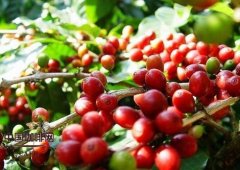About the production cost of coffee, where is coffee expensive?
In the past few years, the world boutique coffee market has experienced several fluctuations, and coffee prices have been rising as a result. The impact of the rising price of raw coffee beans on end consumers is becoming more and more obvious. Many coffee chains and major coffee companies are adjusting the retail price of coffee. How the price of coffee is calculated and whether it is transparent and reasonable has always been a difficult question in the minds of consumers. If we look at the coffee futures market, we will find that the average price of raw coffee beans is $1.75 per kilogram today, while it usually costs $9 to $12 per pound to buy roasted coffee in the market. So what on earth caused the huge price difference between the two? Ric Rhinehart, then president of the American boutique coffee association SCAA, said that the price difference between raw and cooked beans was not simply an artificial price hike. In fact, the transportation and roasting of coffee beans will incur costs, and these costs will be included in the cost of coffee production.
First of all, there are significant costs for the cultivation, maintenance and certification of coffee, including labor fees, fertilizer fees, quality supervision fees, certification fees (such as Organic Certification (Organic), Rainforest Alliance Certification (Rain forest Alliance), Fair Trade (Fair Trade) Certification, etc.), transportation and franchise fees (if the grower is a member of a planting alliance). If the controllable expenses such as labor costs are relatively easy to calculate, then other uncontrollable expenses caused by different producing areas and different planting areas are difficult to predict. This will make it difficult to unify the wholesale price of raw coffee beans in the country of origin.
Second, once the coffee beans are picked and processed, they are bought by local exporters, resold to importers, and finally sold to roasters. Roasters bear the bulk of the cost of coffee production. They need to negotiate wholesale prices with wholesalers and pay wholesalers for the import and transportation of raw beans. During the roasting process, the weight of the coffee is reduced by 18%, so the actual weight of one pound of roasted beans is only 0.82 pounds. What does the loss of weight mean? Let's assume that the purchase price of coffee roasters is $2.25 per pound. If the weight of coffee beans shrinks, that means the price of roasted beans rises to $2.75 per pound. If you add in labor costs and other expenses, the price of a pound of coffee beans will reach $6.50. Of course, the roaster also has to reserve some of the profits, so the final price bought by the coffee shop is about $7.50.
Cafes are the next link in this supply chain. "everyone knows that the price of a cup of coffee in a coffee shop is about $3.50," Linhart said. It usually takes a pound of beans to make 50 cups of coffee, so in theory, coffee beans sell for $175 per pound in a coffee shop. However, coffee growers sell coffee beans for only $2.25 per pound. " But if we look at it from a practical point of view, you can't make 50 cups of coffee with a pound of beans. All coffee shops that follow the SCAA guidelines of the American Fine Coffee Association use 3.75-4 ounces of coffee to make 64 ounces of coffee. The coffee consumers buy weighs 16 ounces per cup. This means that coffee shops consume a pound of beans for every 15-17 cups of coffee they make. If the coffee shop sells $1.95 per cup of coffee, they sell a pound of coffee for only $30. These sales also need to throw out the rent, labor, facilities and other fixed fees, so the profit of the coffee shop in the end is not as substantial as it thought.

Important Notice :
前街咖啡 FrontStreet Coffee has moved to new addredd:
FrontStreet Coffee Address: 315,Donghua East Road,GuangZhou
Tel:020 38364473
- Prev

# counter-cultural Coffee # Coffee varieties that teach you Coffee interpretation of Common acronyms for Raw beans
Pay attention to the raw bean information, in addition to the clear name of the country and region, there are often many acronyms inside the label. When you meet for the first time, you often don't know what to say: DP: Dry Process, dry EP: European Preparation, European standard. It is common in Central and South America. It means that, on the basis of the classification of raw beans, in order to meet the special needs of some European raw bean merchants
- Next

Is your sense of taste right? The effect of taste on coffee drinking
Release time: 2016-04-28 10:10:51 browsing: 19 views went to Komake.com to communicate in 1901 A German scientist published an article on taste research, describing the phenomenon that some areas of the tongue are more sensitive to a particular sense of taste. This is not a clear scientific conclusion, but it gives people the illusion that several areas on the tongue are only responsible for a specific kind of taste.
Related
- Beginners will see the "Coffee pull flower" guide!
- What is the difference between ice blog purified milk and ordinary milk coffee?
- Why is the Philippines the largest producer of crops in Liberia?
- For coffee extraction, should the fine powder be retained?
- How does extracted espresso fill pressed powder? How much strength does it take to press the powder?
- How to make jasmine cold extract coffee? Is the jasmine + latte good?
- Will this little toy really make the coffee taste better? How does Lily Drip affect coffee extraction?
- Will the action of slapping the filter cup also affect coffee extraction?
- What's the difference between powder-to-water ratio and powder-to-liquid ratio?
- What is the Ethiopian local species? What does it have to do with Heirloom native species?

